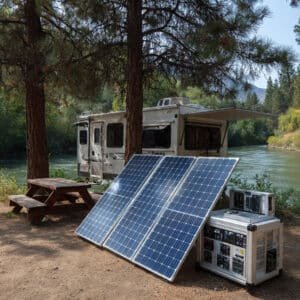Most homesteaders have their own aquaponics system or are at least considering building one. Building your own aquaponics system may seem like a complicated task but if you do the necessary research, you could be enjoying a self-sufficient life in no time.
Why Build An Aquaponics System?
Aside from being self-sufficient, there are plenty of other reasons why you should start an aquaponics system right in your own backyard. For one, it is great for the environment. We only have one Earth and unless someone does a Thanos and snaps half of the world population away, our natural resources will be gone real soon. Of course, we’re not promoting genocide here. We’re just pointing out that humans, in general, are notorious for ruining whatever good there is around them. That’s why we have pollution, global warming, flooding, and other disasters.
With an aquaponics system, you save up on water through recycling. It produces fewer pollutants, waste, and runoff that may contribute to the depletion of the environment. In fact, large-scale aquaponics farmers use only 2% of the water needed in traditional farming.
You also have no need for fertilizers since your system will be producing its own organic nourishment. Best of all, you know what your plants and fish have been through. Your produce will be pesticide-free since you really don’t have a need for it. Weeding is also no longer necessary so there’s no fear of herbicide residue in the food you eat. You’ll also be sure you won’t be munching on growth hormones and antibiotics in your fish.
Aquaponics System Checklist
Fish Tank
You’ll be raising fish so you obviously need a fish tank. The size of your tank will depend on how many fishes you plan to have. Ideally, the tank should be 3 to 20 gallons big. You can either use plastic or glass. Your tank will also require standpipes and tank stands.
Clarifiers and Bio-filters
Clarifiers will get rid of solid materials, ammonia, and nitrates in your culture water. Bio-filters, meanwhile, are necessary to remove the pollutants since it is important to keep the water clean.
Water Pump

A water pump is necessary to pump water around your aquaponics system. This process makes it possible for the water to be cleaned by the bio-filters. It also pumps clean water into the tank. A 3 to 4-watt pump is sufficient for small systems. You’ll also require plastic or vinyl tubing. Don’t use copper tubing. Make sure you get one that fits the water pump outlet.

Gravel
Fill your tank with 2.5 pounds of gravel for every five gallons of water.
Oxygen System

Your aquaponics system will not work without an oxygen system. The fish and plants will need air courtesy of an air pump with the help of an air stone. You also need tubing to connect the pump and air stone.

Grow Bed

The grow bed contains the medium where you will grow your plants. It should be a bit bigger than the fish tank. The grow bed will go on top of your fish tank.
Grow Media

Simply put, a growing medium is a material where your plants will grow. Peat moss, river rock, perlite, and coconut coir are a few examples of growing mediums perfect for your aquaponics system.

Plants and Fish
Most importantly, you need fish and plants that will support each other. The fish will supply your plants with nutrients while the plants will keep the water clean for the fish. You’ll need items for taking care of both plants and fish such as gardening tools, fish nets, and thermometers.
Other Items

There are other things that you may need for your aquaponics system. If you have ornamental tropical fish, you’ll need an aquarium heater. You can also add lights for both your fish and plants.

A litmus kit will help you determine the pH of the water. You can also use a pH meter or a pH test kit. Tools such as a hand drill, electric tape, and such will come in handy as well as a wash basin for cleaning your produce and other items.
Building Your Aquaponics System
Now for the fun part. The initial thing to do is to place the gravel in your fish tank. Make sure they are washed thoroughly first. Put the water pump in the fish tank then place the grow bed. Don’t forget to drill holes two square inches apart at the bottom of your grow bed. The holes will let the water flow into the tank. Make a bigger hole for the plastic tubing, which you will connect to the water pump. Loop some of the tubings around the inside of your grow bed. Cut and seal the end with electric tape then make little holes on the part of the tubing that’s in the grow bed.
Put your grow media in your grow bed. It should be deep enough to reach just below the top of the plastic tubing. Bury the tubing with the growing medium.
Fill the fish tank with water then turn the water pump on. Make sure the grow bed is getting water. Next, set up your oxygen system by attaching the air tubing to the air stone and air pump. The air stone is then placed in the fish tank. Bubbles should appear in the water once you plug in the air pump.

Check the water pH and make sure it’s not lower than 6.8 and not higher than 7.2 pH. The ideal figure is 7.0 pH. Use a pH control kit to make the necessary adjustments. You also need to get rid of the chlorine in the water. Use a chlorine remover if you want things done immediately. Otherwise, let it sit for 24 hours to allow the chlorine to completely dissipate.
Once you’re sure there’s no more chlorine in the water, add your fish. For your fish density, there should be 1/2” of fish for every gallon of water. After a month or so or when your aquaponics system is established, you can add more fish until the density is 1” of fish for every gallon.
You can plant a few seeds or seedlings in the grow bed if you wish to see it done immediately. However, the ideal time to start planting is four weeks after setting up your aquaponics system.
Some Tips On Starting Your Own Aquaponics System
Starting Small
First, you need to consider starting small. Unfortunately, aquaponics gardening is not for everyone. Some just can’t find the time or resources to do it. If you want to try it out first, it’s better to start with micro-farming or by building a hobby-scale aquaponics system.
If budget is an issue, you can choose to DIY your aquaponics system. There are some items in the checklist that you can make from cheap parts instead of purchasing them for a higher price.
Choosing the Right Fish
There are two reasons for raising fish in your backyard. First, you’ll have an endless supply of fish meat so you’re less likely to go hungry. Second, fish produce natural fertilizer for your plants. Some farmers, particularly vegetarians are not too fond of consuming their fish so that leaves them with reason number 2, which is actually a good enough reason why you need an aquaponics system.
You should decide on the type of fish you want in your system. The ones most suited for your aquaponics system include carp, catfish, tilapia, trout, and goldfish. Other options include bass, bluegills, angelfish, guppies, and perch.
Choosing What to Grow
Most houseplants will grow in your aquaponics system. The most popular ones, however, are herbs and leafy vegetables such as lettuce and spinach.
Location
You’re dealing with water and soil so there’s always the possibility of spilling water and mud. Find a place that is okay to be a little messy. It should also be easy to clean up. Furthermore, find a secure location for your aquaponics system. Keep young children and pets away so there’s little risk of drowning or electrocution. Also, choose a place that’s not directly under the sun. The heat of the sun may cause changes in the water’s temperature, which is not good for the fish.
Power
You need power for your aquaponics system to fully function. Make sure you have a backup source in case the power goes out.
Adding More Fish
Keep your aquaponics system disease-free by placing new fish in quarantine before adding them into your tank. Wait three to five days before introducing the new fish to your system.
Start building your aquaponics system now so you can reap the rewards as soon as possible. The sooner you get it done, the better your chances of surviving are in case of emergencies. If you grow and raise your own food, you’ll have a bit of security in case of sudden unemployment, societal breakdown, economic collapse, or other tragic scenarios that may affect the food supply around the country.
Dive deeper into aquaponics through this step-by-step guide on how to build your own system by Aquaponics 4 You. Here, you will learn more details about the aquaponics system including how to produce around “4,000 pounds of organic vegetable per month” and how to make a profit out of your hard work.
There are other ways you can be self-sufficient such as breeding chickens and growing potatoes at home. Check out The Gentleman Pirate for more information about homesteading and living off the grid.

Just a disclaimer – We have partnered with these companies because we use their products and/or proudly trust and endorse them – so we do receive a commission if you make a purchase or sign up for services. Often, we are able to negotiate special discounts and/or bonuses, which we will pass on to you via our links. We often get short notice on sale items available for 24-48 hours as we will pass these savings onto you.






















